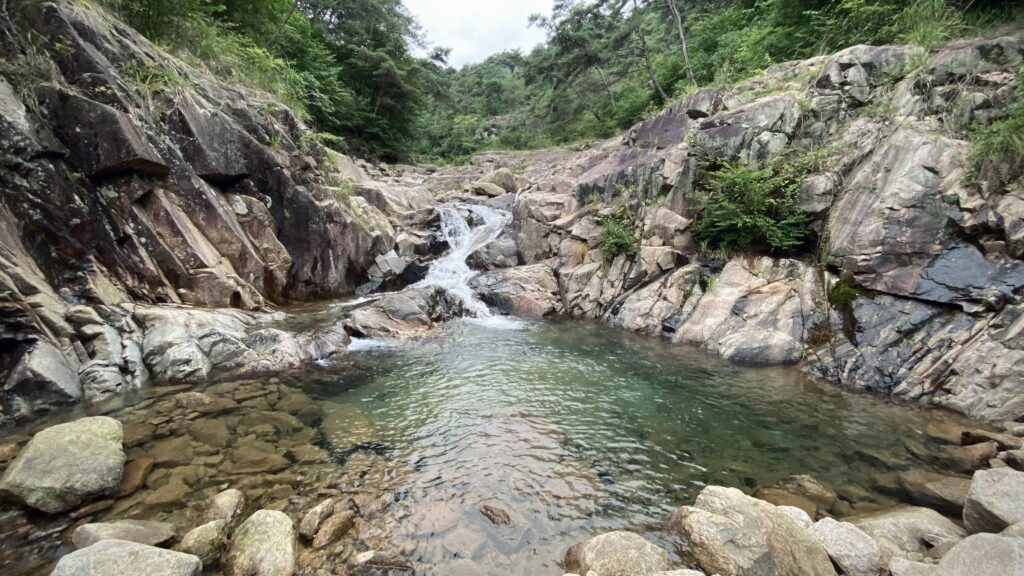A Tale of Two Valleys
Swimming Deep in the Mountains of Namwon
By Isaiah Winters
Last summer, I spent a week in Gokseong scouring Dongak-san’s best valleys for swimmable pools of pure, mountain spring water. Being a creature of habit, this summer I’ve drifted just a hair north to Namwon to do the same in the valleys of Goribong. Fortunately, the new pair of valleys I’ve found are no less impressive than those featured last summer, thanks in large part to these areas’ shared proximity and geography. So, in this Namwon edition, we’ll take a deep dive into Saejeok Valley (새적골) and Manhakdong Valley (만학동 계곡).

To get to Saejeok Valley, it’s as easy as parking at the bottom of the valley right next to the waters of the boulder-strewn Seomjin-gang and hiking up. The drive from Gwangju takes about 50 minutes, while the hike only takes about 15 minutes. I stick to the right side of the valley when hiking up, as that’s where the trail is clearest. You’ll see a few boulders spray-painted in red that mark the way. The first has a large number “380” on it, and the next has a wedge-shaped symbol that looks like a caret pointing roughly towards the water. Not long after the caret, you’ll see a few burial mounds in the distance, which is too far; the best pools are somewhere in between on the left. Sadly, the more trash you see, the closer you are. I normally wouldn’t share this location in such detail, but I doubt many will be making the journey.
Saejeok Valley is straight, narrow, and stunning. The pools are long rather than wide, and they feature many terraced cascades that spill into a series of swimmable pools. Go higher and the valley forms a tight, high-walled gorge with denser vegetation, deeper pools, and higher cascades. The best pool I reached featured a bifurcated waterfall that flowed on either side of a giant boulder and had a depth of about three meters. I couldn’t hike any higher due to the steep, slippery rocks surrounding this pool, and I never found a clear trail leading beyond the aforementioned burial mounds, but if you do manage to find a path beyond this point, I suspect the pools get even better. There are some drawbacks to this valley, however. While the steep valley walls provide sufficient shade, the tradeoff is that the boulders below remain extra slippery because they never dry out, so you have to watch every step. Also, beware that there’s poison ivy along the trail.

Moving slightly north, Manhakdong Valley couldn’t be more different. It’s flatter, wider, and stripped clean of most vegetation as it gradually snakes its way up the face of Goribong. It’s as if a meandering glacier carved it out of the mountainside, leaving only the distant margins with any hint of shade. This valley’s pools are generally shallower and warmer, as the waters flow over a larger surface area of smooth, sunbaked rocks. Though mostly placid, I discovered that a fork at the high end of the valley had a lot of loose boulders and sediment, indicating there had been a significant landslide just a few years before. After seeing this, more than once I imagined a flash flood triggering a deafening rockslide of crackling boulders and uprooted trees surging down at me with unstoppable force. This ambient fear kept me vigilant whenever I sensed a change in the clouds or a sudden chill in the air.
Not wanting to get pulverized by loose debris, I headed back down to the lowest point of the valley to scout for any more pools. Along the way, I encountered about a dozen poisonous fire-bellied toads, which display their bright red bellies and secrete a milky toxin when threatened. Many of these little amphibians were generous enough to pose for the camera, so I’m quite chuffed with how several of my pictures turned out. Anyway, once you get back down to where the trailhead first meets the valley, keep going down the valley a bit further for the best pools. One is especially wide with plenty of adjacent rock walls to jump from, making it among the best pools I’ve ever found. As it’s only about a minute or two below the trailhead, after your swim, you can conveniently hike back to the parking lot at the tiny tea farm of Maewoldang (매월당). To make the most of the experience, maybe try some local tea beneath the shade of the farm’s traditional thatched roofs. You’re welcome!
The Author
Born and raised in Chino, California, Isaiah Winters is a pixel-stained wretch who loves writing about Gwangju and Honam, warts and all. He’s grateful to have written for the Gwangju News for over six years. More of his unique finds can be seen on Instagram @d.p.r.kwangju and YouTube at Lost in Honam.





